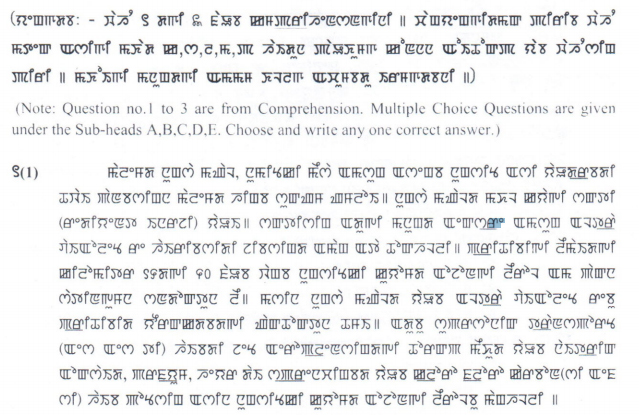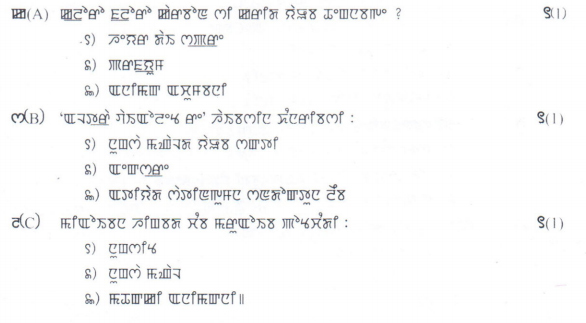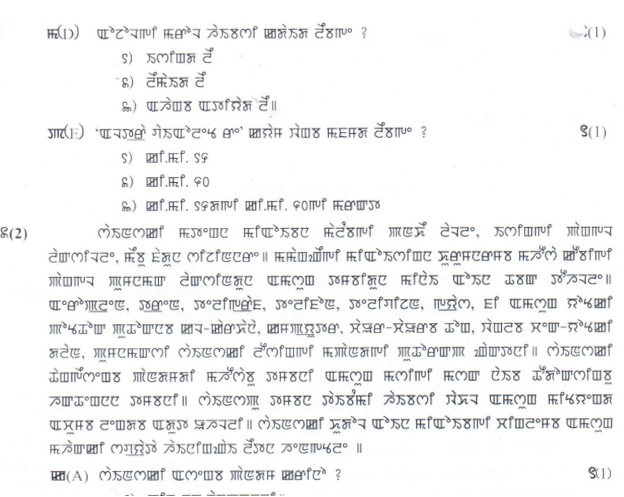
(Download) CBSE Class-12 2016-17 Sample Paper And Marking Scheme (English Elective)
Time allowed: 3 Hrs
Maximum Marks: 100
The Question paper is divided into three sections:
Section A – Reading 20 marks
Section B – Writing and Grammar 40 marks
Section C – Literature 40 marks
General Instructions:
i. All the questions are compulsory.
ii. You may attempt any section at a time.
iii. All questions of a particular section must be attempted in the correct order.
SECTION-A
(Reading : 20)
1 Read the passage given below and answer the questions that follow :
1. The Ring at Casterbridge was merely the local name of one of the finest Roman amphitheaters, if not the very finest remaining in Britain. Casterbridge announced old Rome in every street, alley, and precinct. It looked Roman, bespoke the art of Rome, concealed dead men of Rome. It was impossible to dig more than a foot or two deep about the town fields and gardens without coming upon some tall soldier or other of the Empire, who had laid there in his silent unobtrusive rest for a space of fifteen hundred years.
2. Imaginative inhabitants, who would have felt an unpleasantness at the discovery of a comparatively modern skeleton in their gardens, were quite unmoved by these hoary shapes. They had lived so long ago, their time was so unlike the present, their hopes and motives were so widely removed from ours, that between them and the living there seemed to stretch a gulf too wide for even a spirit to pass. The Amphitheater was a huge circular enclosure, with a notch at opposite extremities of its diameter north and south. It was to Casterbridge what the ruined Coliseum is to modern Rome, and was nearly of the same magnitude. The dusk of evening was the proper hour at which a true impression of this suggestive place could be received. Standing in the middle of the arena at that time there by degrees became apparent its real vastness, which a cursory view from the summit at noon-day was apt to obscure.
3. Melancholy, impressive, lonely, yet accessible from every part of the town, the historic circle was the frequent spot for appointments of a furtive kind. Apart from the sanguinary nature of the games originally played therein, such incidents attached to its past as these: that for scores of years the towngallows had stood at one corner; that in 1705 a woman who had murdered her husband was half-strangled and then burnt there in the presence of ten thousand spectators. In addition to these old tragedies, pugilistic encounters almost to the death had come off down to recent dates in that secluded arena, entirely invisible to the outside world save by climbing to the top of the enclosure, which few townspeople in the daily round of their lives ever took the trouble to do.
4. Some boys had latterly tried to impart gaiety to the ruin by using the central arena as a cricket-ground. But the game usually languished for the aforesaid reason - the dismal privacy which the earthen circle enforced, shutting out every appreciative passer's vision, every commendatory remark from outsiders - everything, except the sky; and to play at games in such circumstances was like acting to an empty house. Henchard had chosen this spot for meeting his long-lost wife. As Mayor of the town, with a reputation to keep up, he could not invite her to come to his house till some definite course had been decided on.(498 words) Adapted from: The Mayor of Casterbridge, Thomas Hardy (1886)
1.1 On the basis of your understanding of the above passage, answer the following questions briefly:
(a) What was the name given by the locals to the ancient Amphitheatre at Casterbridge?
(b) What was the attitude of the local residents to the unearthed remains of dead Romans?
(c) Over the years what had the amphitheater been used for by the locals?
(d) Why had the boys stopped using the amphitheater for their game of cricket?
(e) Why did Henchard want to keep secret his meeting with his long-lost wife?
1.2 Choose the meaning of the words/phrases given below from the given options:
(a) Concealed (Para 1))
(i) silent
(ii) hidden
(iii) dead
(iv) lonely
(b) Hoary (Para 2)
(i) unimaginative
(ii) buried
(iii) ancient
(iv) mummified
(c) Pugilistic encounters (Para 3)
(i) vindictive meetings
(ii) powerful fights
(iii) boxing matches
(iv) brave acts
(d) Secluded (Para 3)
(i) one
(ii) private
(iii) close
(iv) hidden
(e) Sanguinary
(i) blood-thirsty
(ii) strange
(iii) peculiar
(iv) vampire
2 Read the passage given below and answer the questions that follow: Across the Kashmir Valley and over the famous Zoji La pass lies Ladakh - the Land of High Passes. It is a magical land, completely different from the green landscape of many other parts of the Himalayas. It is nature at an extreme. A land of freezing winds and burning hot sunlight, Ladakh is a cold desert lying in the rain shadow of the Great Himalayas and other smaller ranges. Little rain and snow reaches this dry area, where natural forces have created a fantastic landscape.
This region once formed part of the erstwhile Kingdom of Ladakh, believed to have been inhabited by the early colonizers of Ladakh - the Indo-Aryan Mons from across the Himalayan range, the Darads from the extreme western Himalayas, and the itinerant nomads from the Tibetan highlands. Also, its valleys, by virtue of their contiguity with Kashmir, Kishtwar and Kulu, served as the initial receptacles of successive ethnic and cultural waves emanating from across the Great Himalayan range. Thus, while the Mons are believed to have carried north-Indian Buddhism to these highland valleys, the Darads and Baltis of the lower Indus Valley are credited with the introduction of farming and the Tibetans with the tradition of herding. The aridity of Ladakh is due to its location in the rain shadow area of the Great Himalayas, as well as because of its elevation and the radiation of heat from the bare soil. The most striking physical feature of Ladakh, however, is the parallelism of its mountain ranges. In Ladakh, large rivers and their tributaries have carved deep gorges far below their steep banks. However, their water is not of much use, as the terraced fields lie high above the gorges. The region is extremely dry, with rainfall as low as 10 cm each year. These valleys sustain an exclusively agrarian population of about 80,000 people who cultivate the land available along the course of the drainage system, wherever sources for artificial irrigation are available. The majority of the population is Muslim. Descendants of missionaries of Kashmir who introduced Islam, locally called Aghas, still hold sway over the population, perpetuating the faith even as ancient folk traditions with Buddhist and animistic undertones are palpably present. Many folk traditions, particularly those connected with the agricultural cycle, are still followed with subdued reverence.
During the last decade a gradual change in the tourist's perception of Ladakh has come about, thanks to the growing mystique of the Himalayas and a burgeoning interest in adventure tourism worldwide. As a result of this change in perception there has been a steady increase in the number of tourists to the Western flank of Ladakh, which comprises several river valleys. Chief among these are the spectacular valleys of Suru and Zanskar, nestling along the foothills of the main range of the Greater Himalayas; the smaller lateral valleys of Dras and Wakha-Mulbek, as also of Chiktan (still in the restricted zone) constitute important subsidaries. Drained and formed by the southeastern tributaries of the high Indus, these valleys constitute the district of Kargil.
The itinerary of the average tourist to Ladakh begins with a tour of Leh, the ancient capital and principal township of Ladakh. It invariably includes visits to a selection of monasteries located along a stretch of the Central Indus Valley, between the spectacular monastery of Lamayuru in the west and the prestigious establishment of Hemis in the east. Some take to trekking along the lateral valleys, especially in Markha, but few venture out of the confines of the central Indus valley, which represents Ladakh's heartland.
(a) On the basis of your understanding of the above passage make notes on it using headings and sub-headings. Use recognizable abbreviations (wherever necessary-minimum four) and a format you consider suitable. Also supply an appropriate title to it.
(b) Write a summary of the passage in about 80 words.
SECTION : B
(Writing and Grammar )
(Marks:40)
3 The Drama Club of KMN International School is staging an adaptation of the popular Shakespearean tragedy, Julius Caesar, the proceeds of which will be used for a charitable cause. Design a visually appealing poster for this in about 50-60 words. Include all relevant details.
OR
You are Komal/Karan, the Sports Captain of Rose Public School, Chandigarh. Your school has decided to allow students to use the swimming pool during the summer vacations. There will also be specialized coaching for beginners. Draft a notice in about 50-60 words informing students about this. Include all relevant details.
4 You are Ramesh/Rashmi of 151 Chandan Nagar, Delhi. Write a letter in about 120-150 words to the Manager, Elvys Crockery Store, Delhi, placing an order of crockery and cutlery for your newly opened restaurant.
OR
You are Karuna/Kailash staying at B-101, Yamuna Vihar, Delhi. You find it inspiring that hill stations in India, like Ooty implement a strict ban on polythene bags which helps in preserving the natural beauty of the place. Write a letter in about 120-150 words to the Editor of a national daily expressing your views on how people in the city can learn from this and be more active in prevention of environmental degradation. Also suggest ways to mobilise city dwellers for being eco-friendly.
5 You are Neerja/Nitin, a reporter with ABVP News India, posted at Ghaziabad. You are one of the first group of reporters who reached the accident site near the Gajraula toll booth where a luxury bus with 54 foreign passengers on board from Delhi met with a head on collision with a water tanker. Write a report in about 150-200 words for the newspaper giving details of loss of life and damage caused.
OR
You are Satish/Saba, associated with an NGO which works to uplift the socioeconomic conditions of child labourers by counselling their parents and helping them to go to school. Write an article in about 150–200 words on the role of literacy in eradicating the evil practice of child labour from society.
6 On the occasion of World Health Day prepare a speech in about 150-200 words for the morning assembly on healthy eating habits in the face of a fast paced stressful lifestyle.
OR
Your school has invited you to address your former school mates during a special assembly after you have successfully cleared the UPSC Civil Services Examination with top honours. Prepare your speech in 150-200 words, motivating and giving them tips on how to achieve success in the examination.
(A) Rearrange the following words and phrases into meaningful sentences.
(a) courage / history/ women / change/have the / mankind's/ to /the/course of.
(b) equal/ women/ no true / decision making/ at all/there can/ governance and development / participation of / levels of/ be /without
(c) limits/ for/success/ any/ women/I / key/think/ set/ the /to/ is/ to not
(B) The following paragraph has not been edited. There is one error in each line. Write the error and the correction in your answer book against the correct blank number. Underline the word you have supplied.





